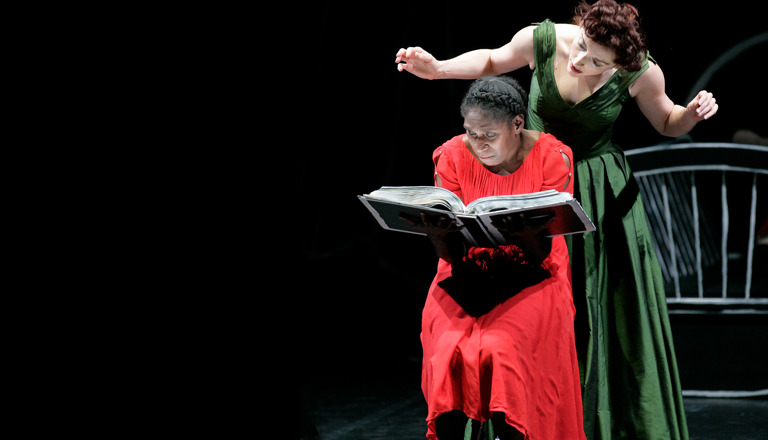Mathinna (2008)
Before Viewing
Bangarra’s production of Mathinna is based on the true story of a young Tasmanian Aboriginal girl called Mathinna, who lived in the early 1800s. The story tells of her personal journey and illustrates some of the key political, cultural and social interactions that occurred at the time of colonisation.
The focus of the production is the social disruption that occurred as British settlers relocated the Aboriginal people from their tribal lands, intervened in their cultural practices and challenged their traditional values.
THINGS TO THINK ABOUT AND DO - FOR YEARS 5/6
What do students already know and what are some things they can do?
- Encourage the students to experience moving their body both individually and with others; showing awareness of their body in space and in relation to objects around them.
- Give them opportunities to develop an awareness of their ability to isolate different parts of their body and make specific actions and gestures.
- Include cross lateral movements in movement activities.
- Ask students to make contrasting shapes with their body (curved/angular; symmetrical/asymmetrical).
- Assist students to understand that movements can be used to explore and improvise dance ideas by controlling and combining different movement qualities.
- Give students opportunities to know that it is possible to show similarity and contrast through movement. For example: Can they change the size and speed of their movement and follow pathways on the floor or in the air?
- Provide opportunities for students to practice controlling movement by pausing or freezing, and using contrasting qualities such as smooth and sustained, followed by percussive movement.
- Have students form groupings such as lines or group shapes, and lead or follow others in these groupings, moving close together and/or far apart.
- Give them experiences which assist them to understand that movements can be joined together in order to move on the spot or travel in different ways.
- Check that students are aware that they can interpret meanings from watching dance and that dances can tell a story which may have a beginning, middle and end?
- Encourage students’ recognition that people from different cultures dance and may have different reasons for dancing.
- Assist students to understand that when an audience member, it is important to concentrate on experiencing the dance by watching and listening.
Pose questions that help them understand the ideas that the dance is based on?
- Who is Mathinna and what do we know about her?
- Where in Australia are Port Davey, Flinders Island, North West Bay?
- Who were Mathinna’s parents and where were they from?
- Who was George Augustus Robinson and what did he have to do with the history of the Tasmanian Aborigines?
- Who are Sir John and Lady Jane Franklin?
- What was life like for the early European colony in Hobart Town? For the free settlers, for the convicts, for the Aborigines?
Expand students understanding that contemporary Indigenous people participate in all facets of the community and as artists they may choose to communicate ideas based on traditional stories including those relating to animals that represent spirits.
- Who are the Aboriginal people/s who live in Tasmania?
- What is a cultural advisor?
- Who are the dancers of Bangarra? Where do they come from?
- Where is the company Bangarra based?
THINGS TO THINK ABOUT AND DO - FOR YEARS 9/10
What do students already know and what are some things they can do?
- Encourage the students to experience moving their whole body and isolating different body parts.
- Give them opportunities to transfer their weight from one part to another and utilise different body bases.
- Ask students to use increasingly complex combinations of space including level, direction, dimension, shape, planes and pathways.
- Encourage students to use combinations of time: including metre, tempo, accent, and phrasing.
- Provide opportunities for students to use combinations of dynamics.
- Ask students to move both individually and with others; showing awareness of spatial relationships, groupings and in relation to other dancers and to objects around them.
- Assist students in gaining confidence in interacting with others and showing emotional connections and expression.
- Encourage students to use a variety of choreographic devices including abstraction, transitions, variation and contrast and to recognise different forms and structures.
- Check that students are aware that choreographers use the elements of dance to express intent.
- Encourage students’ recognition that dance can relate to its social and historial context.
- Assist students’ understanding that there are specific protocols for viewing and performing Aboriginal and Torres Strait Islander dances.
Pose questions that help them understand the ideas that the dance is based on?
- Who is Mathinna and what do we know about her?
- Where in Tasmania are Port Davey, Flinders Island, Hobart and Oyster Cove?
- Who were Mathinna’s parents and where were they from?
- Who was George Augustus Robinson and what did he have to do with the history of the Tasmanian Aborigines?
- Who are Sir John and Lady Jane Franklin?
- What was life like for the early European colony in Hobart Town? For the free settlers, for the convicts, for the Aborigines?
Expand students’ understanding that contemporary Indigenous people participate in all facets of the community and as artists they may choose to communicate ideas based on traditional stories including those relating to animals that represent spirits.
- Who are the Aboriginal people/s who live in Tasmania?
- What is a cultural advisor?
- Who are the dancers of Bangarra? Where do they come from?
- Where is the company Bangarra based?
Based on Australian Curriculum, Assessment and Reporting Authority (ACARA) Level 3 statements from the Critical and creative thinking learning continuum for generating ideas, possibilities and actions, Reflecting on thinking and processes and Analysing, synthesising and evaluating reasoning and procedures areas. Licensed under a Creative Commons Attribution-NonCommercial-ShareAlike 3.0 Australia (CC BY NC SA) licence. Accessed June 2013.

